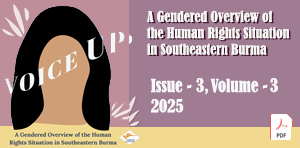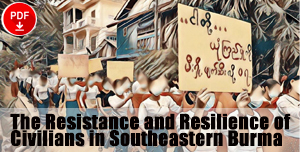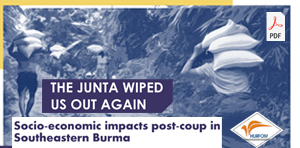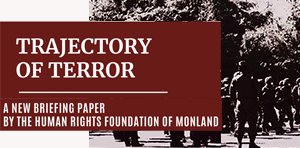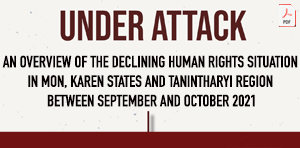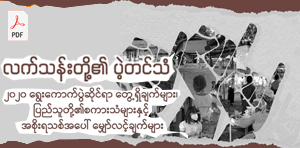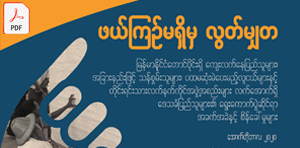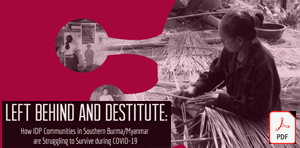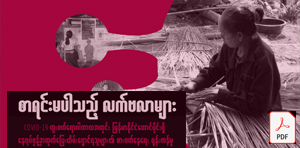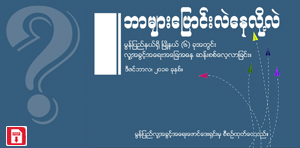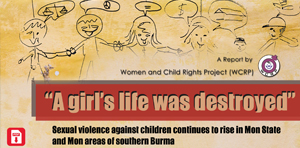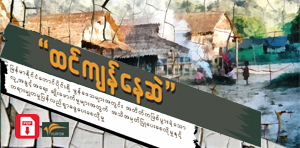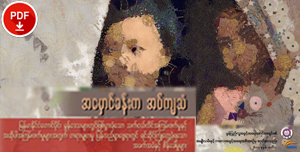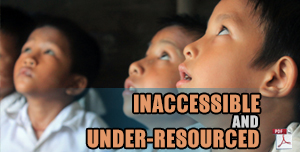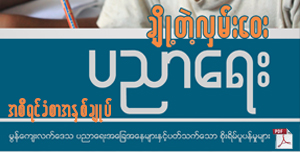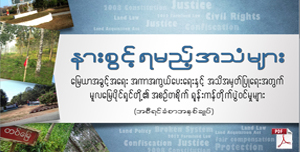Monthly Overview: Attacks Persist in Southeastern Burma Amid Earthquake Relief Efforts as Junta Continues to Deploy Aerial and Ground Assaults While Weaponizing Humanitarian Aid
April 28, 2025
HURFOM April 2025
On March 28, 2025, a 7.7-magnitude earthquake in Burma caused the death of thousands, with many more remaining missing and others injured. The tremors were felt nationwide but were particularly catastrophic in Sagaing and Mandalay as century-old buildings and religious sites collapsed. In targeted areas of the Human Rights Foundation of Monland (HURFOM), including Mon State, Karen State, and the Tanintharyi region, there was considerable damage to several villages and buildings, as well as flooding due to rivers overflowing.
In response to the earthquake, local rescue efforts quickly began to help find survivors and treat the injured. International relief efforts were also underway when the junta began imposing limitations, including allowing access to neighbouring allies such as China and India, but denying emergency assistance teams from Taiwan. Even during a harrowing natural disaster, the junta has not ceased to deploy attacks against sheltering civilians or those seeking refuge in neighbouring states and regions, after the loss of their homes.
Less than 48 hours after the attack, on the night of March 29, at 10:45 PM, junta forces launched indiscriminate artillery shelling from Waw Township, Lat Pan village in Bago Region, near the Mon State border, across the Sittaung River. The shells struck Khaywe village in Monsu Ward, Kyaik Hto Township, Mon State— areas already suffering from the aftermath of the recent earthquake. Despite this, the junta showed no regard for humanitarian principles and deliberately fired heavy artillery at civilian areas.
Two elderly civilians were injured in the attack: U Kappali (72 years old) and Daw Kyun, his wife. The couple sustained injuries when a shell landed near their home, with U Kappali suffering severe wounds to his right arm, which required 16 stitches. The shells were fired from Lat Pan village using 81 mm artillery. This incident is a heartbreaking reminder that even in the wake of a natural disaster, the junta continues to disregard civilian safety and international humanitarian law.
The attacks since the earthquake have been ongoing, even after the junta declared a ceasefire. As such, communities across the country continue to suffer from the devastating impacts of war and natural disasters. At 5:30 PM on April 1, 2025, junta Battalion Light Infantry Battalion No. (12), positioned at a newly established artillery base, fired five rounds of 120mm artillery shells into Wait Sar Kone village, Kyon Doe Township, Karen—despite the absence of any active fighting in the area.
Tragically, a 57-year-old woman was killed. Witnesses say she was struck with such shock by the blast that she fell backwards, hitting her head and suffering fatal brain injuries. While thousands of civilians are already displaced and struggling to survive after losing their homes and possessions, the junta continues to target peaceful villages. Their attacks have not spared religious sites, hospitals, schools, or residential communities.
This incident is yet another heartbreaking reminder of the dangers faced by innocent people every day.
Indiscriminate Firing
Attacks on innocent people in Burma continue unabated. Despite the overwhelming evidence of the junta’s brutality, there has been a regrettable lack of effective action to halt the violence inflicted upon local communities.
Two civilians were injured and a home was destroyed after junta troops launched artillery shells into a village in Mon State’s Thanbyuzayat Township. The attack occurred on the evening of April 5, at around 6 p.m., when artillery fired from the Waekalee-based military command exploded inside the residential area of Kalaing Padaw village. There was no active fighting in the area at the time.
“A 120mm artillery shell landed and exploded in someone’s yard. A man and a woman were injured, and the house caught fire,” said one resident.
The injured were identified as Nai Kin, 38, and his wife, Mi Tin, 36. Nai Kin reportedly sustained severe injuries to his right hand and abdomen, while Mi Tin was hit on her left arm and right leg. Their home, owned by Daw Mee, was also completely destroyed in the fire, and five family members have been displaced. The couple is now receiving medical treatment at Mawlamyine General Hospital.
Despite the junta’s announcement of a temporary 20-day ceasefire due to earthquake-related concerns, artillery shelling and airstrikes have continued in parts of Mon State and other areas. Since the beginning of this year, junta attacks in Mon State have increased, including the use of heavy weapons and aerial bombings. Civilian casualties have also been on the rise.
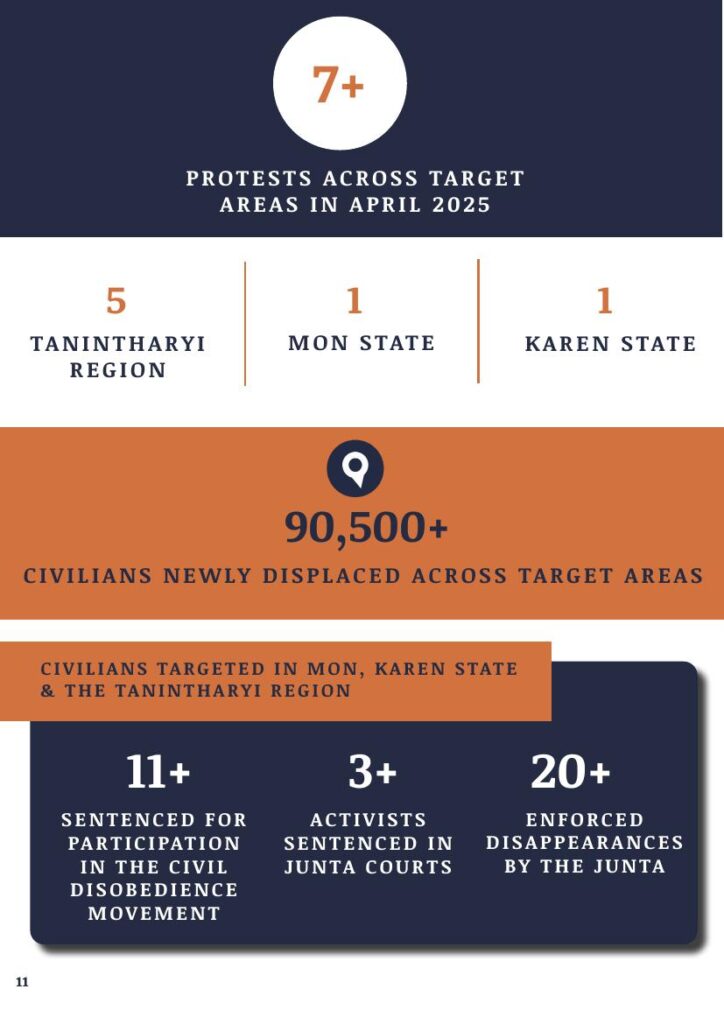
Resistance groups report that junta forces have been targeting not only homes, but also schools, churches, monasteries, and religious sites with these indiscriminate attacks. Local communities remain in fear, as even areas far from conflict lines are no longer safe from these brutal assaults.
In Launglon Township, Dawei District, junta forces have been launching indiscriminate artillery attacks on civilian areas, while also advancing on foot towards Min Yat village, according to local sources. Artillery shells have reportedly continued to be fired from Dawei town. On April 10, clashes broke out near the Myanmar Customs Department in Kyatsarpyin Ward, Dawei town. Following the fighting, junta troops began mobilizing and moving towards Launglon Township.
At 5:30 AM on April 11, troops were seen advancing toward Min Yat village. Between 9:00 AM and 11:00 AM, the junta’s artillery unit stationed in Dawei reportedly fired at least seven mortar rounds toward areas near Wai Dee, Danitaw, Shin Gyi Eain, Inn Zout, and Ywa Haung Wa villages.
In addition, junta troops reportedly arrested a young man, Than Htaik Oo, in his 20s, from Ywa Haung Wa village. He was working in a rubber plantation near Min Yat when he was detained. Local sources added that, in addition to artillery shelling from Dawei, the junta is also using high-end drones to drop bombs on villages. As a result, many residents are being forced to flee their homes in search of safety.
Despite no clashes reported in the area, two civilians were injured and several homes destroyed after junta airstrikes hit villages in Hpapun Township, Karen State, according to a statement released by the Karen National Union (KNU) Headquarters. On the evening of April 8, at 5:30 PM, junta jet fighters dropped two bombs on Balaewor and Htee Thae Khlu villages. The sudden airstrikes forced many to flee their homes in fear.
As a result of the attack, residents Saw Pana Mu and Saw Dae Si were injured. Homes belonging to Saw Karnae Mu, Saw Pana Mu, and Saw Daw Ne in Balaewor Village were heavily damaged. In Htee Thae Khlu, the home of Naw Kyar Hae and several others was also hit and partially destroyed.
This assault occurred despite the junta’s recent announcement of a temporary ceasefire in response to the earthquake disaster. However, communities across several states and regions continue to experience daily artillery shelling and airstrikes.
As families fled deadly airstrikes and heavy shelling in Kawkareik Township, Karen State, Junta troops from Light Infantry Battalion 545 and Infantry Battalion 546 stopped them at checkpoints and demanded money and valuables. These displaced villagers, already traumatized by ongoing attacks, have faced intimidation, harassment, and demands for money along the way.
The abuses reportedly began after heavy military assaults on April 15, when junta aircraft and artillery began targeting several villages in and around Kyon Doe Town. In response, hundreds of families fled their homes in terror. At least 80 people were stopped on their way to safety and forced to give money or belongings to junta soldiers on the road.
One villager who is now staying in Mawlamyine shared what happened:
“Our family fled on the 15th after our village was hit. We hid in a bomb shelter for four days with barely any food or clothes. I have three young children, including an eight-month-old. The baby’s mother was so traumatized that she stopped producing milk. Eventually, we tried to escape to Mawlamyine, but were stopped by soldiers from LIB 546. They held us for three hours. Then, they demanded 50,000 kyat per person. Some families had to pay 100,000 to 300,000 kyat. If they had no cash, they were forced to hand over watches or jewelry. It was humiliating, terrifying. Those were some of the worst days of our lives.”
Local rescue groups estimate that nearly 2,000 families from at least eight villages, including Koh Boh, Tadar Oo, Thayet Taw, Koh Khite, Koh Kyaik, and Kanni, have fled since April 15. Most have attempted to reach Mawlamyine or Hpa-an, relying on friends, relatives, and monastery shelters for refuge. Many report that junta soldiers have set up strict inspection points on key exit routes, demanding money or confiscating belongings under threat.
A humanitarian aid worker from a Mon rescue organization, speaking anonymously, confirmed the ongoing hardship.
“As of April 23, Kawkareik town remains under tight junta control. Fierce fighting continues on the outskirts, and airstrikes in surrounding villages like Kyon Doe and Kamanee are ongoing. Civilians cannot assist each other across villages because the roads are too dangerous. People mostly rely on their communities and organize their limited resources to help one another. There’s an urgent need for food and medicine, but the area is essentially under siege.”
From April 14 to 18, the junta carried out a wave of bombings across Kawkareik, displacing more than 10,000 people from at least 40 villages, according to independent local sources. Most of these civilians—primarily women, children, and the elderly—are now scattered across temporary shelters in Mawlamyine and Hpa-an Townships. Monasteries, civic networks, and volunteer groups are coordinating to provide food, clothing, and basic health support, but the situation remains critical.
The extortion of civilians during armed conflict is a clear breach of international law. Under the Geneva Conventions, civilians must be protected from violence, threats, and coercion. The forced extraction of money and valuables from those fleeing conflict, especially when conducted at gunpoint, constitutes a form of pillaging, which is explicitly prohibited under international humanitarian law.
Fighting continues to rage in and around Kawkareik. By the end of April, HURFOM reported that airstrikes have targeted not only homes but also schools and monasteries. Local reports confirm that on April 15, junta airstrikes killed at least 15 civilians, including monks, and injured over 30 more in Kawkareik Township alone. The attacks have paralyzed humanitarian rescue efforts. Even aid organizations operating from Mawlamyine and Hpa-an have been unable to safely access rural areas due to the risk of renewed air attacks and ambushes.
“Every day, more people are trying to escape,” one health volunteer said. “But there are no safe vehicles to pick them up. Those who can afford it pay for their transport. Others try to slip through the forest when the shelling stops. It’s heartbreaking. They’re not just fleeing war—they’re running from extortion and fear.”
Currently, monasteries in Mawlamyine are hosting hundreds of new arrivals. Volunteers report that many of them are elderly people, mothers with small children, and students who left with nothing. Civil society organizations, religious leaders, and Mon political parties have stepped in to provide whatever assistance they can, but without external support, the relief effort may not be sustainable.
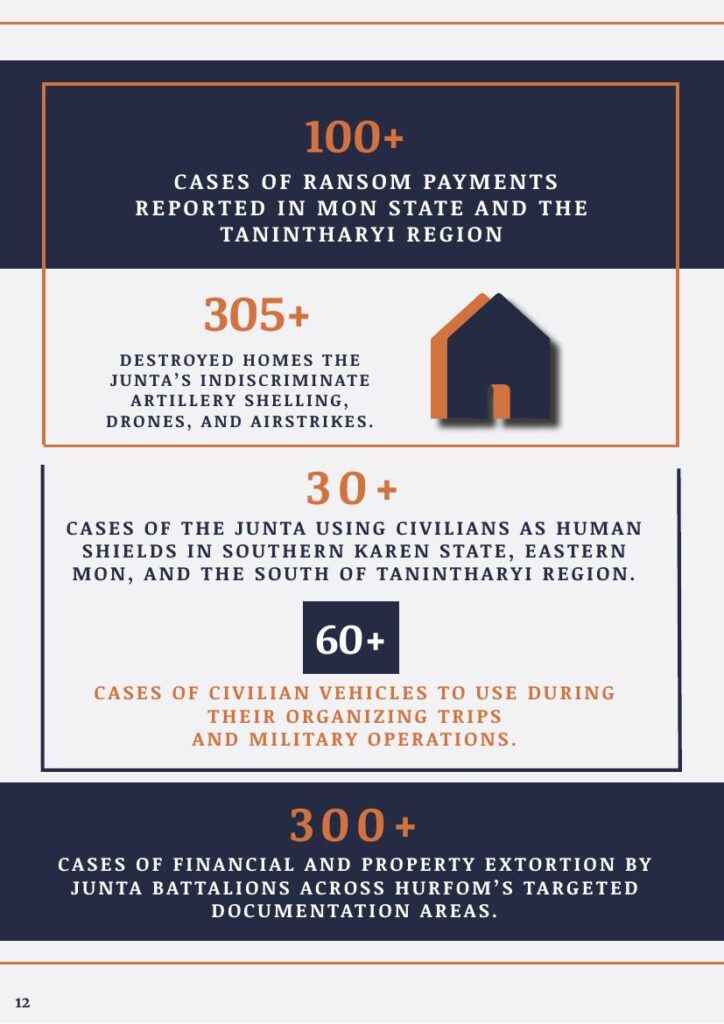
Forced Conscription
The junta’s illegal and unjust conscription effort is ongoing. A group of young men who were deported from Thailand back to Burma through the Kaw Thaung border were being forcibly recruited into military training by the junta. Among them, five attempted to escape. One successfully fled, while four were recaptured. Their families and relatives reportedly do not know their whereabouts. According to local sources, these individuals were taken to the Light Infantry Battalion No. 431 in Kaw Thaung Township for military training. The escape reportedly occurred in late March.
“Most of the people deported from Thailand to Kaw Thaung have been sent directly to military camps for conscription. This has been going on for some time. Many of them are from different regions of Burma,” said a resident of Kaw Thaung.
Witnesses confirmed that one of the five who escaped — a 20-year-old local man named Ko Minn Minn — managed to get away. He had previously been detained in Thailand for illegally entering the country and was deported from Ranong to Kaw Thaung Town in the southern Tanintharyi Region.
“Those who are not familiar with the area don’t know how to avoid arrest. Only one managed to escape,” said a source familiar with the situation.
Ko Minn Minn has expressed his desire to return to Thailand, where his family is currently staying. Arrangements are being made to help him reunite with them. There is still no information about the condition or whereabouts of the four others who were recaptured after attempting to flee alongside him. Locals expressed serious concerns about the junta’s ongoing efforts to forcefully conscript returnees into military service. They hope for stronger measures to prevent such abuses, especially for those being sent back from Thailand.
Since March 2024, the junta has intensified its campaign of forced conscription, targeting returnees from Thailand without notifying their families. Many families remain unaware of the fate of their loved ones who are being taken by force.
Airstrikes are also continuing to occur in Mon State. On April 17th, at noon, junta airstrikes dropped two bombs each on Thon-Sat-Thon-Su Village and Kyaik Tha Lite Village in Daung Pha Lan village tract, Kawkareik Township, Karen State. According to preliminary reports, a school building in Kyaik Tha Lite and a residential home in Thon-Sat-Thon-Su were hit. One woman was reportedly injured. HURFOM is currently verifying the full details of the incident.
“A school in Kyaik Tha Lite was seriously damaged, and a few houses were also hit. What’s certain is that there were no armed resistance forces active or based anywhere near these villages. This was an indiscriminate attack,” said a 37-year-old male resident of Kyaik Tha Lite.
Following the bombing, many villagers sought safety in the nearby forests, gardens, and hills, setting up makeshift shelters wherever possible. “Some have even started digging bunkers there to protect themselves in case of another airstrike,” the resident added.
In yet another blatant attack on civilians, junta forces launched multiple airstrikes on April 19 on villages near the Winwa Police Station in Thayetchaung Township. The indiscriminate bombing resulted in the deaths of a grandfather and his 7-year-old grandson, and injuries to at least four others, including a woman.
At approximately 10:30 AM, military aircraft dropped an estimated eight bombs on Yange, Chaungwa Pyin, and Mindat villages. Eyewitnesses confirmed that two bombs directly struck Yange village.
“One of the bombs hit the center of the village. A grandfather and his grandson were killed instantly,” said a resident.
Reports further indicate that several homes were damaged, and residents are now living in fear of further attacks. No active clashes were reported in the area at the time of the bombing, underscoring the indiscriminate nature of the junta’s campaign.
The incident follows a wave of attacks over the previous 24 hours. On April 18, resistance forces launched an operation targeting the junta’s Winwa base around 6:00 AM. Gunfire exchanges continued until the evening, with the junta retaliating at 4:00 PM by bombing areas near the Winwa base and nearby bridge, using a jet fighter to drop six bombs. Later, around 11:30 PM, another round of airstrikes was conducted, despite there being no ongoing fighting.
“There was no confrontation when the bombs were dropped. The attacks appear to be designed solely to terrorize and displace civilians,” said a resident of Waeyit village, located near the affected areas.
Military analysts and local human rights monitors warn that the junta is rapidly escalating its operations in the southern Tanintharyi Region—particularly in areas surrounding the Dawei Special Economic Zone (SEZ), a strategic investment zone backed by Russian interests. This includes intensified troop reinforcements and increased air operations.
Earlier this afternoon, a young man named Paing Oo, currently taking refuge as a displaced person, warned his fellow villagers about possible military activity in the area. Using internet access from the Thai side of the border, he reported seeing junta aircraft flying overhead. He urged everyone to stay extremely alert, noting that the junta appears to be preparing military operations near Yange, Kywe Minn Kone, Kyauk Khamuak, and other surrounding villages in Dawei District.
At the same time, all phone and internet services in those villages have been cut off by the junta, making it nearly impossible for locals to receive early warnings or updates on the unfolding conflict. This has left residents in a highly vulnerable situation, with no access to communication and at significant risk of being caught in attacks without any notice.
On the morning of April 19, at 11:45 AM, three Mi-17 transport helicopters reportedly landed at Dawei Airport, delivering an estimated 100 additional soldiers to the area. Human rights defenders warn this may signal a wider campaign of repression and urge heightened vigilance and preparedness among local communities and aid organizations.
Karen State
In Hpa-pun Township, Karen State, three young girls were injured in a landmine explosion while walking along the bank of the Salween River near Kamamaung Town. The incident occurred at 5 PM on April 10. The victims were identified as Ma Zin Myat Noe (12 years old), Ma Kyae Zin Lin Thant (17), and Ma Zin Thida Theint (12), all from Ward No. 3 in Kamamaung Town. The girls were walking together near the river when the explosion happened.
Locals said the area where the landmine detonated is a frequently used path. Ma Zin Myat Noe stepped on the mine, suffering the most serious injuries, while the two other girls were also wounded by shrapnel from the blast. All three girls sustained injuries to their legs and hands due to the explosion. Zin Myat Noe, who was most severely hurt, is at risk of losing her leg and has been transferred to the General Public Hospital in Hpa-an for urgent treatment.
It is still unclear which group planted the landmine, as there have been active military movements by both the junta forces and Karen National Liberation Army (KNLA) joint forces in the area around Hpa-pun Township.
Further, a series of worsening attacks in Karen State included days of airstrikes in which women and children were killed. HURFOM condemned the violence in a statement on 18 April 2025. In Kawkareik Township, Karen State, junta forces have continued their indiscriminate attacks on civilian areas using both artillery and drones. These brutal offensives have left at least eight innocent people, including young children, injured, and several homes damaged or destroyed.
On the evening of April 10, 2025, at approximately 6:00 PM, junta troops stationed in Kawkareik Town launched a drone strike on Maungma Ywa Thit village. The attack injured a 10-year-old girl, a 55-year-old man, and a 50-year-old woman—all local villagers. Just two days earlier, on the night of April 8, around 10:27 PM, the junta launched more artillery attacks using 120mm and 122mm heavy weapons. Shells landed in several villages, including Ankaung, Kyaiktalite, and Daukphalan in Kawkareik Township.
The shelling damaged civilian homes in Ankaung village, injuring five more people: a 40-year-old man, a 26-year-old man, a 14-year-old girl, a 9-year-old boy, and a 6-year-old boy. These targeted attacks on residential communities came in the aftermath of the devastating earthquake in the country, during what should have been a time of rescue and relief efforts. Instead, the military junta has continued its deliberate assaults on unarmed civilians, deepening the suffering of those already in crisis.
Then, on the early morning of April 16, at 6:00 AM, junta forces launched a deadly airstrike using jet fighters and heavy artillery on Nwar Chan Gone village, near Kyon Doe Town in Kawkareik Township, Karen State. The bombs hit villagers and vehicles preparing to flee the area, killing at least 14 civilians.
Witnesses confirmed that junta jets and drones bombed areas where residents were organizing evacuation plans. Among the dead are a husband and wife whose bodies have been recovered. Others remain buried under the debris and have not been retrieved yet.
“One of the victims is Ko Ganan, around 40 years old, and his pregnant wife. They were both killed. They were Hindu. We’ve only been able to recover their bodies so far. At least 14 people were killed in total. Everyone else is still running for safety,” said a local aid worker supporting displaced villagers.
The deadly airstrike occurred during Burma’s New Year Water Festival (Thingyan), when many civilians were gathered in villages and monasteries. The same area had been attacked just a day earlier, on April 15, when the junta bombed Kanni village monastery in Kyon Doe, killing six civilians, including four children between the ages of 3 and 15.
The attack reportedly involved jet fighters and Y12 bomber aircraft, which dropped approximately 15 bombs across multiple locations, including Koh Wah Lae, Tharyar Gone, Nwar Chan Gone, and surrounding areas. Homes and farmlands were directly hit, causing severe damage.
“The air force dropped bombs twice in Kyon Doe, and three more times in Kawkareik Township using Y12 aircraft. The bombs hit residential areas. It’s terrifying,” said a local monitoring source.
At the same time, junta troops from Light Infantry Battalions 545 and 546 are reinforcing their bases in Kyon Doe. Soldiers from LIB 97 are shelling routes near the Asia Highway and the old Daungtaung road, preparing to launch ground operations in Kawkareik Township.
On April 16, just after 12:40 PM, the junta launched yet another airstrike targeting civilians in Karen State, this time dropping bombs on Myaukkanmayaik village, Kawkareik Township, using a Harbin Y-12 aircraft.
A pregnant woman, just days away from giving birth, was tragically killed on the spot. At least six other civilians were seriously injured, including a 7-year-old child. The attack occurred during the traditional Thingyan New Year festival, when most villagers were home participating in religious and cultural ceremonies. Myaukkanmayaik is home to nearly 3,000 people and over 600 households.
“The woman, Ma Hnin Oo, who died was 37 and heavily pregnant. She had just been helping her three-year-old son when a bomb struck her back. She died instantly. The unborn child did not survive either. While the toddler was physically unharmed, he is now deeply traumatized and showing signs of emotional distress,” said a local man in his 40s.
A member of a frontline medical team, who wished to remain anonymous, expressed outrage:
“Even after Malaysia’s Prime Minister called for a ceasefire, the junta continues to target civilians, even during the Thingyan holiday. This isn’t just happening here; it’s a widespread problem. It’s now crystal clear that the junta does not intend to engage in real peace talks. ASEAN leaders, including Malaysia, must understand that continuing to engage the junta while turning a blind eye to these atrocities amounts to enabling war crimes and legitimizing impunity.”
Another local CBO staff member based in Kawkareik shared:
“This year’s Thingyan has become a painful and bloody memory. We won’t forget. One day, justice must be served. I also urge our ethnic resistance organizations—Karen and Mon alike—to take real responsibility in protecting civilians. They must ensure that civilian areas are not used as shields and must issue early warnings when military operations are expected. In addition to physical protection, we need collective efforts to provide humanitarian support—food, medicine, and safe shelters.”
Following the airstrike, more than 200 villagers have fled Myaukkanmayaik, taking refuge in nearby plantations and forest areas out of fear of further attacks.
This heartbreaking attack came just one day after junta jet fighters bombed a monastery in Kanni village and carried out a deadly assault on Nwar Chan Gone village near Kyon Doe Town in Kawkareik Township, Karen State.
At least 20 civilians were killed, including four children between the ages of 3 and 15. Junta forces—particularly Infantry Battalions 545 and 546 stationed in Kyon Doe, along with Battalion 97 based in Kawkareik—have continued escalating their military operations across the region, launching relentless artillery shelling and airstrikes on civilian areas.
The next day, at 8:00 AM on 17 April 2025, the junta launched yet another devastating airstrike—this time targeting Thayettaw village in Kawkareik Township, Karen State. According to a field source from HURFOM’s human rights monitoring network, two bombs were dropped by a jet fighter directly onto the village. One male villager was killed instantly, and at least four others were seriously injured, including two men and two children.
“This happened without warning. The jet appeared suddenly, and within moments the bombs dropped—no time to flee, no time to hide,” said a 35-year-old local volunteer assisting displaced villagers. “People scattered in panic, trying to take shelter in bomb shelters, irrigation ditches, or under homes. Many elderly people, women, and children were crying and screaming. It’s terrifying. We don’t know when the next strike might come—or why we are being targeted at all.”
Thayettaw is a densely populated village with approximately 720 households and a total population of over 3,800. The vast majority of residents were still in their homes, as the attack took place on the First Day of the Thingyan festival—a time usually marked by peace and community gatherings.
HURFOM’s documentation team confirmed that the two injured children, both around 10 years old, were rushed to Mawlamyine for emergency treatment by local rescue teams. The condition of the two wounded adult males remains unknown.
This latest assault follows the horrifying pattern of recent attacks carried out by the junta in Karen State: “The strike on Thayettaw village is part of the junta’s escalating pattern of violence against innocent civilians during what is supposed to be a peaceful holiday,” added a 40-year-old local humanitarian worker.
“No armed groups are operating in or near this village. This is not a battlefield—it is a deliberate attack on ordinary people. They are targeting families, homes, and children.”
As of now, more than 400 households from Thayettaw have fled into nearby fields, orchards, and forests, fearing additional airstrikes. Many left behind their homes, livelihoods, and belongings in search of safety. Thalwehtaw village, located in Kyon Doe Town, Kawkareik Township, Karen State, was once again targeted by junta airstrikes on April 18, marking the fifth consecutive day of attacks in the area. According to local sources, one civilian was killed and several others were injured when military aircraft dropped bombs on the village at approximately 8:45 AM on April 18, 2025.
Despite the ongoing battles near Kyon Doe, the airstrikes hit areas with no direct connection to active fighting. Residents have been fleeing their homes in large numbers, seeking safety in nearby forests, gardens, and makeshift shelters, fearing further attacks.
These repeated attacks come despite the junta’s public announcement of a nationwide ceasefire from April 2 to 22, supposedly to allow for relief and recovery efforts in the aftermath of the devastating earthquake. In reality, the junta has continued to violate its ceasefire declaration, conducting airstrikes, shelling civilian villages, and arresting locals in several townships across Karen State.
The local inhabitants in Kawkareik Township, Karen State, targeted communities, already traumatized by natural disaster, now face additional hardship and fear under relentless military assault.
Thalwehtaw village, located in Kyon Doe Town, Kawkareik Township, Karen State, was once again targeted by junta airstrikes on April 18th, marking the fifth consecutive day of attacks in the area. According to local sources, one civilian was killed and several others were injured when military aircraft dropped bombs on the village at approximately 8:45 AM.
Despite the ongoing battles near Kyon Doe, the airstrikes hit areas with no direct connection to active fighting. Residents have been fleeing their homes in large numbers, seeking safety in nearby forests, gardens, and makeshift shelters, fearing further attacks.
These repeated attacks come despite the junta’s public announcement of a nationwide ceasefire from April 2 to 22, supposedly to allow for relief and recovery efforts in the aftermath of the devastating earthquake. In reality, the junta has continued to violate its ceasefire declaration, conducting airstrikes, shelling civilian villages, and arresting locals in several townships across Karen State.
The local inhabitants in Kawkareik Township, Karen State, targeted communities, already traumatized by natural disaster, now face additional hardship and fear under relentless military assault.
Thousands of civilians remain trapped in Kawkareik Township as fierce fighting between junta forces and resistance groups continues for over a week. Junta troops have sealed off all entry and exit points, leaving residents without safe passage, while relentless airstrikes, drone attacks, and artillery shelling have created a dire humanitarian crisis.
The clashes intensified following joint resistance offensives targeting junta camps along the Kawkareik-Kyone Doe highway starting April 14. As of April 21, heavy fighting persists, especially near Kawkareik’s northern and western outskirts. Locals report that junta forces have prohibited residents from fleeing and are actively blocking humanitarian routes.
“This has been going on for more than a week. We’re running out of food and water. Some families have taken refuge in bomb shelters and underground bunkers, but children and the elderly are in desperate need of food and medicine,” said one resident who remains trapped in the town.
Humanitarian groups estimate that more than 7,500 people have fled Kawkareik Township in recent days, but thousands more are still inside the town, unable to escape. Many report living in fear, unsure whether they will die of hunger or be caught in the next round of fighting. Religious and community leaders in the town have attempted to negotiate humanitarian corridors with the junta, but those talks appear to have stalled.
“People here are surviving on whatever dry food and water they can find. Junta troops won’t let anyone leave. Goods can’t come in either. It’s a suffocating blockade,” said another trapped resident. “It feels like we’re waiting to die—either from bombs or starvation.”
The situation is particularly severe given the junta’s ongoing indiscriminate attacks across southeastern Burma. Recent airstrikes in Kawkareik Township, Bilin Township, and Dawei District—including direct bombings on monasteries, schools, and civilian homes—have killed and injured scores of people. Just days ago, an airstrike on a monastery in Minn Saw village, Bilin Township, killed a 10-year-old novice monk and two women, injuring eight others.
Despite the humanitarian catastrophe, cross-border assistance remains severely limited. The eastern Thai-Burma border remains largely closed, making it nearly impossible for vital supplies, like food, medical kits, tarpaulins, and baby formula, to reach displaced populations. The suspension of U.S. cross-border aid following the Executive Order has worsened the crisis, cutting off a crucial support line for local ethnic service providers and humanitarian responders.
Humanitarian workers estimate that at least 42 villages in Kawkareik Township alone have been displaced, pushing the total number of newly displaced persons to nearly 100,000 in Karen State and surrounding areas. Needs for food, medicine, and emergency shelter have surged, but international response remains alarmingly absent.
“We need international humanitarian organizations to step in and help—urgently,” said a local aid volunteer. “The junta has made it impossible for people to survive. No one is safe, and no one is getting the help they need.”
Mon State
Residents in Mawlamyine, Mon State, are facing distress after the junta’s municipal department issued threats to demolish more than 100 homes by April 10, claiming the buildings were constructed illegally. The affected homes are located in Oak Pho Quarter, Hlaing Ward—a residential area where land plots were initially sold during the National League for Democracy government’s administration, with prices ranging from 10 to 20 million kyats each.
According to residents, the junta has issued three separate warnings stating that these houses were built without official permits. While the land was once designated for agriculture, it was later divided and sold by cronies and local officials. Now, many ordinary citizens who purchased the land in good faith are at risk of losing their homes.
“They’ve already sent us three notices,” said one homeowner. “The first came from the land records department, and now the municipal office is following up. Many houses have already been torn down.”
An official letter from the junta-controlled Mawlamyine Municipal Department cites permit No. La/Na (39) and claims that unauthorized buildings have been constructed on an 11.239-acre plot. The department says all such structures must be demolished, including over 100 existing homes, most of them well-built, along with another 100 vacant plots that have yet to be developed.
“This land originally belonged to farmers,” explained another resident. “Later, cronies and some officials worked together to change the land documents and reissue them under a new permit. They sold the plots to people who trusted that the documents were legal.”
Residents say they have appealed to the junta-appointed Mon State Chief Minister and other authorities for help. However, officials have only approached the original land sellers, who have not provided a solution. The municipal office, meanwhile, has yet to resolve the matter, even after residents engaged with the land records department.
As the April 10 deadline looms, many affected families are in crisis. Some have already been forced from their homes and are now taking shelter at monasteries and religious sites. Others are choosing to remain in their homes despite ongoing threats of demolition.
This is not the first warning from the authorities. On December 26, 2024, the municipal department issued a similar notice, but only half of the targeted homes were demolished at the time. Now, a third and final warning has been issued, stating that any remaining structures will be removed and legal action taken under Mon State’s municipal law if homeowners do not comply.
According to reports from junta sources, the demolition orders were based on instructions from Colonel Kyaw Swar Myint, Minister of Security and Border Affairs in Mon State, during a government meeting in Mawlamyine on January 10.
In addition, civilians remain constantly at risk of being arrested or killed for what are often baseless accusations regarding ties to the opposition movement. In Kyaikhto Township, Mon State, junta forces shot and killed a local man based on unverified allegations that he was supporting local resistance groups. After the killing, they also took away his body. The incident took place near the cemetery in Sootpanu Village. The victim, U Aung Kyaw, owned a local fish farming business.
At 5 AM on April 4th, a convoy of five military trucks carrying over 50 junta troops arrived at his fish farm. Shortly after, they shot and killed U Aung Kyaw. Locals believe the junta acted on a vague and unconfirmed claim that U Aung Kyaw was helping resistance forces. According to community members, he had previously been rumoured to support local resistance by providing food supplies and helping gather information.
U Aung Kyaw was known in the village as a peaceful fish farmer in his 50s. His sudden death has shocked and frightened local residents, especially given the lack of concrete evidence behind the accusation. Just days earlier, on April 2nd, another young man in his 20s was reportedly shot and killed in his home in Mokkhamu Village, also in Kyaikhto Township. According to locals, two unidentified gunmen entered his house and opened fire.
The increasing violence and targeted killings have caused fear and distress in many Mon communities, especially as unverified suspicions are being used to justify lethal force.
At around 11:00 AM on April 19th, junta forces launched an airstrike on a monastery in Minn Saw village, located in Bilin Township, Thaton District, Mon State. The bombing killed two civilians and seriously injured two novice monks.
“Junta aircraft dropped bombs while the monks and volunteers were preparing the midday meal at the monastery,” said a local villager. “Two female laypeople who were helping prepare the meal were hit by bomb shrapnel and died instantly. One senior novice and a younger novice were also badly injured. The monastery building itself was severely damaged. The entire village had to flee in panic, unsure when the next strike might come. Only a few men stayed behind to protect the village.”
Residents estimate that the bombs dropped were likely 500 pounds, though military experts have not yet confirmed this. The impact was so powerful that the bodies of the two deceased women were reportedly torn apart.
One of the injured novices is said to be in critical condition, raising concerns for his survival.
“They’ve bombed our Minn Saw village repeatedly. This time, the damage is much worse,” said a villager who identified himself as Saw Nwe. “It’s been almost two school years now that our children haven’t been able to attend classes due to the fear of more attacks.”
Minn Saw is a Karen ethnic village in Bilin Township under the administrative area of the Karen National Union (KNU), Brigade No. 1. Since the military coup more than four years ago, the village has frequently come under attack from the junta’s indiscriminate shelling and airstrikes.
On April 24, 2025, two civilians were injured in separate artillery attacks across Theinzayat Sub-town, Kyaikhto Township, Mon State, after junta forces from Artillery Regiment Command No. 310 launched a series of indiscriminate shellings into residential areas. The assaults, which began at 12 PM, targeted Mon Su ward, Karaway Seik, Taungtusu, Kyauk Pon, and Winka villages, spreading fear and destruction across multiple communities.
Two of the victims, Ko Htain Linn Aung, 34, and Ko Aung Htoo, 35, were injured when artillery shells exploded near U Thila Pagoda in Mon Su ward. Both sustained injuries to their legs. Due to safety concerns and fear of further junta violence at public hospitals, they were transported to a clinic located within an Ethnic Resistance Organization-controlled area for medical treatment.
Another resident from Kyauk Pon village sustained minor injuries later that evening during a separate shelling. He is currently receiving treatment at a clinic in a resistance-held area.
A former CDM Civil Servant, who recently lives and takes refuge in an Armed Resistance-controlled area in Kyaikhto, described that the military fired six 120mm shells, with at least two landing in populated areas. “The junta’s strategy hasn’t changed—they shell in all directions, hoping to hit resistance fighters, but in reality, they’re hurting innocent people,” he said.
“Their belief is that resistance forces are hiding among the public, but it’s the Junta using civilians as human shields with their bases inside towns. It’s a war crime, and we’ve said this time and again.”
Shells also landed in Kyauk Nhyat village, near the western bank of the Sittaung River. No injuries were confirmed at that site at the time of reporting, but residents reported damage to homes and property.
Ground volunteers working on the front lines confirmed that Artillery Regiment Command No. 310 has routinely targeted villages around Theinzayat with heavy weapons. Villages such as Sitkwin, Khone Kwa, Mokkamah, Wargatkwin, and Khaywe have frequently come under fire. According to a local humanitarian worker, these attacks have left at least seven people dead and more than 30 injured over the past year.
“This is how people live now,” said a 30-year-old member of a local emergency response team. “They can’t farm or leave their homes without fear of being shelled. Schools, pagodas, and clinics—none of them are safe anymore.”
“The shelling never seems to stop. My family and so many others from my hometown are living in constant fear, displaced, hiding, or just trying to survive as explosions echo every day. Honestly, we don’t know when or if this fear and suffering will ever end,” said a resident from Theinzayat Town.
Tanintharyi Region
The presence of the military junta in the Tanintharyi region has continued to spark fears and alarm over the uncertainty of an attack or act of violence by the regime. Unlawful, arbitrary arrests are among the primary tactics used by the junta to exert control. In addition to routine guest registration checks, junta forces in Dawei are now specifically targeting the families and friends of those who have had arrest warrants issued against them.
Nighttime raids have intensified across several wards, where soldiers are searching for individuals connected to resistance groups, People’s Defence Force (PDF) members, and others listed in their arrest records. These lists reportedly include full names, addresses, and details of those they intend to locate. Since mid-March, these operations have taken place in wards such as Kyet Sar Pyin, Bhom Maw, Daung Ngu, Kyauk Maw, and Byaw Taw Wa, as well as in Tha Pyay Chaung village.
“This isn’t just a regular guest registration check,” said one Dawei resident. “In Bhom Maw, they conducted a very thorough search—blocking off areas, raiding homes of those with warrants, and inspecting all phones in the houses they entered.”
There are also reports that some of these nighttime inspections are being carried out under secret orders to identify resistance members and their networks in the area. In the last week of March, raids were particularly aggressive in Kyet Sar Pyin and Bhom Maw. In some cases, troops reportedly broke down doors, entered homes without warning, and looted personal belongings.
Junta patrols move through the town in columns, stopping people on the streets, checking their phones, and questioning them. Warning shots have been fired to intimidate residents. Since mid-February, similar operations have been carried out in Dawei’s remote bus station and new town wards. During these raids, guesthouses were searched, and at least 15 people were arrested for not registering as guests. Locals also report being extorted for money during these encounters.
Guest registration inspections remain ongoing at key checkpoints in Dawei, including Ka Myaw Kin Bridge Gate, Pauk Tine Bridge Gate, and Byaw Taw Wa Gate, as well as surrounding neighbourhoods such as Kyet Sar Pyin, Bhom Maw, New Thit, San Chi, Kyauk Maw Gyi, and Byaw Taw Wa ward.
Junta forces that entered the Zar Dee village tract in Yebyu Township, Dawei District, on March 31 have started arresting residents, prompting widespread fear and forcing nearly 1,000 people to flee their homes. Two men in their early 50s and another in their late 30s were arrested in Khaung Pyan village. Several residents of Zar Dee have also reportedly been detained, but due to ongoing communication blackouts, the total number remains unclear.
Since the military arrived, villagers from at least five communities within the Zar Dee tract have been displaced. As of April 2, troops remain stationed in Zar Dee and Khaung Pyan, and most villagers have already fled to seek safety.
On April 1, junta aircraft were seen flying twice over the Zar Dee area, monitoring from the sky and adding to the community’s fear of impending violence. Residents worry that heavy fighting could soon erupt in nearby villages, including Pa Ya, Khway Ma Phaw, Deik Takaw, and Kha Rin Chaung, leading to thousands more fleeing as a precaution.
This is not the first time the area has faced such pressure. After intense fighting in Yay Kan Taung in December 2024, the junta had cut off electricity and internet access in Zar Dee. Although services were briefly restored in early March, the junta warned locals they would be shut off again if new fighting broke out.
In Yebyu Township, Dawei District of Tanintharyi Region, local sources report that nearly 1,000 junta troops have been deployed around villages near the Dawei Special Economic Zone (SEZ), forcing many residents to flee their homes in fear of clashes. Since March 29, over 500 troops have entered Mudoo village, located near the SEZ. Another group of approximately 100 soldiers has also been stationed near Maungmagan. Residents in the area have reported the presence of two separate military columns in Mudoo, and many have already fled for their safety.
On March 31, another wave of troops entered the Zar Dee village tract. Local villagers from Zar Dee, Khaung Pyan, and Deik Takaw villages encountered around 400 soldiers from the junta. At least 12 women and elderly people who remained in the villages were reportedly arrested.
Due to fears of heavy fighting, residents from villages including Paya, Khway Ma Phaw, Zar Dee, Khaung Pyan, Deik Takaw, and Kha Rin Chaung have fled simultaneously. Thousands are now displaced, seeking refuge in safer areas. According to residents, phone and internet services in the affected areas have been cut off by the Junta, making communication and access to information extremely difficult.
“As of April 6, the military is still stationed in our village and the surrounding forests. We had no choice but to flee,” said a resident from Zar Dee.
Since the Junta signed a Memorandum of Understanding (MoU) with Russia to restart the development of the Dawei SEZ, military presence and aerial surveillance in the area have intensified. Daily flyovers by junta aircraft have raised fears among villagers of possible airstrikes.
The military has reportedly reinforced SEZ camps with an additional 300 troops, bringing the total deployment in and around the Dawei SEZ area to nearly 1,000 soldiers, spread across at least five military columns. Fighting already broke out near Lae Shaung village on March 24 and 25, resulting in casualties on both sides.
Locals believe the troop build-up and offensives are part of the Junta’s broader strategy to tighten territorial control before restarting the SEZ project in cooperation with Russia. The sharp increase in military activities and pressure on civilians has only deepened fear and displacement in the region.
Some civilians detained by the junta have been forced to be guides and used as human shields for the junta. On the morning of April 7, junta troops operating near Zardee Village Tract, Yebyu Township, Tanintharyi Region, arbitrarily detained around 20 local men from Phar Chaung Inn village and forced them to serve as porters, according to local sources.
The military column, estimated to be about 100 soldiers, arrived in Phar Chaung Inn at approximately 7:50 AM after advancing from the direction of Zardee village. On arrival, they began detaining men they encountered in the area and forced them to carry military equipment.
“Soldiers came out of the forest and started taking villagers. About 20 men were taken to serve as porters. Most of the other villagers have already fled. People are terrified because of the heavy troop presence,” said one local man.
As the arrests began, residents from Phar Chaung Inn and nearby villages began fleeing their homes early that morning to avoid being targeted. Locals also recalled that on March 31, more than 400 junta soldiers entered the Zardee area and arbitrarily detained several elderly residents and at least 12 women from Zardee, Khaung Pyan, and Deiktakaw villages. Those individuals were held for two days before being released.
With fears growing of further military operations, thousands of residents from Paya, Khwaemaphaw, Zardee, Khaung Pyan, Deiktakaw, and Khayin Chaung have now been displaced, leaving their homes behind in fear of renewed violence.
Although no active clashes have occurred yet, the junta has maintained a strong and regular presence in Zardee Village Tract. On March 18, they cut off electricity and communication lines in the area, followed by the large-scale military movement on March 31.
Since the morning of April 20, 2025, intense clashes have erupted between junta forces and resistance groups in the Minn Thar village tract of Kanbauk Sub-Town, Yebyu Township, Dawei District. Residents reported heavy exchanges of gunfire between the junta troops stationed in Minn Thar and resistance fighters, including pro-junta militias. Gunfire could be heard from 8:00 AM until at least 1:00 PM.
Around noon, the fighting escalated when junta troops from the Mawrawaddy Naval Command and Light Infantry Battalion No. 282 launched artillery strikes toward nearby villages, including Sinku and Yapu. Villagers said shells landed dangerously close to civilian homes in Sinku and within the gardens and farmland west of Yapu village. Fortunately, no casualties were initially reported.
“Junta forces — particularly units from Light Infantry Battalion No. 282, LIB 405, and the Naval
Command — have been conducting military operations in this area for at least a week now,” said one local source, who added that the military has reinforced its troops with hundreds of additional personnel. “They’ve been using heavy artillery to shell our villages in the name of their security randomly,” the villager explained.
“Mortar rounds keep landing inside our communities, and it’s becoming impossible for us to stay. Every time fighting breaks out, they deliberately target civilians. That’s why no one feels safe in their own home anymore. And after the clashes, they come in, loot our belongings, and sometimes even burn down houses. This is the cruel tactic they use. Our people are suffering deeply,” said a military source from Yebyu, familiar with the situation.
On the afternoon of April 19, a junta reconnaissance aircraft was also spotted flying over villages along the Ye-Dawei road near Kanbauk Sub-Town, sparking further fear among the locals. Later, junta troops were seen re-entering Minn Thar village by water route after the fighting had quieted down. According to residents, the troops blocked villagers from leaving and began calling back those who had fled during the clashes.
“They came back right after the fighting stopped. Now, soldiers are stationed inside the village. People aren’t allowed to leave, and some who escaped are being told to return,” said a woman from a nearby village.
The atmosphere remains tense. Many villages surrounding Minn Thar, along with those near the Ye–Dawei motorway, are on high alert, fearing that violence could break out again at any moment. While vehicles are still operating along the road as of this evening, drivers and residents expressed deep concern over the lack of the rule of law and the threat of sudden military violence.
“The road may look normal, but things are far from safe. The military no longer follows any laws. As drivers, we’re just trying to survive every day,” said one local transport operator.
The instability caused by these ongoing attacks, especially the junta’s indiscriminate shelling and aerial threats, has displaced a large number of civilians in Yebyu Township. With no guarantee of safety, hundreds of families are now forced to abandon their homes, seeking refuge wherever they can. The humanitarian toll continues to rise as junta forces push deeper into populated areas, leaving fear, destruction, and displacement in their wake.
The military junta has escalated its attacks in Thayetchaung Township, Dawei District, launching fresh airstrikes on multiple villages amid ongoing clashes. According to HURFOM’s field-based human rights documentation team, the strikes have caused widespread panic, forcing hundreds of civilians to flee their homes in search of safety.
The latest bombings targeted Minn Dat and Kamyaing villages, Thayetchaung Township, which are located near but not directly involved in the recent clashes in Winwa village. “The airstrikes didn’t hit the battle zones,” said one local source. “Instead, they dropped bombs on peaceful villages nearby. This is clearly an indiscriminate attack—everything in the target area was hit.”
Local villagers confirmed that Mi-2 helicopters were used in the recent attacks, dropping at least eight bombs on Minn Dat, Yange, and Chaungwa Pyin villages—all located near the Winwa area. The bombs struck civilian homes and farms, even though there were no clashes reported in those locations at the time.
Tragically, on April 19, junta forces also carried out an airstrike on Yange village, where two civilians, including a young child, were killed. “There were no battles in our village. They just dropped bombs from the air,” said a local from Thayetchaung Township.
The situation in the area had already been tense following a heavy battle on April 19, when anti-junta resistance forces attacked the Winwa police outpost. The fighting lasted from 6:00 AM to around 5:00 PM. That evening, the junta responded with airstrikes around 4:00 PM and again at 11:00 PM, continuing their campaign of terror from the skies.
As a result of the air raids and ongoing battles, entire villages—including Winwa, Thae Chaung, Minn Dat, Waeyit, Chaungwa Pyin, and Yange—have been evacuated, with civilians fleeing en masse into forests, hills, and makeshift shelters.
In a concerning development, local residents in Dawei also reported that three Mi-17 military helicopters landed at the Dawei Airport on April 19, believed to be transporting additional junta troops. Military experts fear this could signal further escalations in the coming days.
“This kind of relentless aerial bombardment shows how little regard the junta has for civilian lives,” said one resident who fled from Minn Dat. “We don’t know when or where the next bomb will fall. People are traumatized, and many have lost their homes.”
Villages in Yebyu Township remain under threat, with ongoing artillery fire and unexploded ordnances continuing to terrorize residents as of April 23, 2025. What began with a devastating artillery attack on the night of April 21 has now escalated into a prolonged crisis, forcing hundreds to flee their homes and seek shelter in nearby fields and farmlands.
At least three houses and a local monastery were struck by junta-fired artillery shells in Sein Bon village, located in the Nat Kyi Sin village tract. The damage was compounded by reports that shells had hit a general store and two homes near Sein Bon station. Though no casualties were reported during that night’s bombardment—thanks to an earlier evacuation—villagers say the psychological toll and physical destruction have been severe.
The Mawrawaddy Navy base in Ohn Pin Kwin village tract reportedly fired heavy artillery toward the area between April 20 and 22, targeting lands near Ya Pu village. Shells also rained down from junta positions based in Kalain Aung, hitting civilian infrastructure and farmlands alike.
“Around Sein Bon village, shells come from both the Mawrawaddy Naval side and the Kalain Aung-based junta forces. The monastery was hit. The school is right next to it. Three houses, including a store, are gone,” a local woman explained.
In addition to structural damage, the aftermath has revealed a more hidden danger: unexploded bombs. Residents report finding live shells in the rubble, making it too dangerous for anyone to return to their homes.
Displacement is rapidly increasing. Entire families from Sein Bon and neighbouring Phayathonezu are now sheltering in makeshift tents in nearby gardens, fields, and even roadside patches—too afraid to go into the forest due to landmines and the risk of further air or artillery strikes.
Food shortages are becoming acute. “As of April 23, some families have nothing left to eat,” said Ko Myo, a 40-year-old resident of Sein Bon. “There are more than 800 people displaced now from Sein Bon and Phayathonezu alone. We’re just trying to stay alive near the village, afraid to move far.”
These events are part of a disturbing trend across the Tanintharyi Region. Repeated airstrikes, ground assaults, and shelling by junta forces have turned homes, religious sites, and schools into targets. Entire communities have been uprooted, with civilians forced to abandon their homes and livelihoods again and again. Insecurity, poverty, and trauma are growing with each attack.
The humanitarian need is now urgent. Displaced families—many of whom are women, children, and the elderly—require immediate support, including food, medical care, and safe shelter. As the conflict escalates, so too does the suffering of civilians caught in the crossfire. The international community must act swiftly to respond to this deepening emergency.
Concerns are mounting in Yebyu Township as two villagers remain detained for over 10 days following their abduction by junta troops in early April, raising fears of forced disappearance and possible mistreatment. While most of those arrested in a recent military sweep have since been released, the whereabouts and well-being of the remaining two men are still unknown.
The two villagers still held in custody are U Than Than, approximately 50 years old, who runs a small food shop in Kyauk Hta Yan village, and Ko Naing Naing, a 40-year-old fisherman from Phyu Nat village.
“The soldiers said they needed U Than Than and Ko Naing Naing to guide them and then took them. They were taken to the Mawrawaddy naval base. Since then, there’s been no word—they haven’t been released,” said a concerned resident of Kyauk Hta Yan.
The wave of arrests began on March 31, when a large junta column, comprising over 400 soldiers, entered Zar Dee, Kaung Pyan, and Dike Ta Kaw villages in Dawei District. Troops detained many residents, including at least 12 women and numerous elderly villagers. Though these individuals were released two days later, the fear and instability they left behind have lasted.
On April 7, the military retreated from Zar Dee and passed through Kyauk Hta Yan, where the two men were taken. That same morning, around 7:50 AM, another group of about 100 troops entered Phar Chaung Inn village, detaining approximately 20 locals from the area and surrounding villages. Most of them were released the next day. Earlier, while occupying Zar Dee village, the junta also detained at least 10 villagers, including three from Kaung Pyan, who were freed on April 5.
Despite the lack of direct clashes, military vehicles have repeatedly entered Zar Dee village, creating an atmosphere of fear. On March 18, junta forces cut off both electricity and internet access in the area. When they returned in force on March 31, they told locals these services would only be restored if the residents returned—an act widely seen as coercive.
Due to these actions and the constant threat of arrest, thousands of villagers from Paya, Khway Ma Phaw, Zar Dee, Kaung Pyan, Dike Ta Kaw, and Kha Yin Chaung have fled their homes.
The extended detention of U Than Than and Ko Naing Naing without charge or access to their families raises serious concerns about inhumane treatment, interrogation under duress, or worse. Locals fear they may have been tortured or forcibly disappeared—yet, so far, there has been no transparency or accountability from the junta.
With more civilians being arbitrarily detained and communication cut in key areas, the humanitarian situation in Yebyu Township is becoming increasingly dire.
As fighting intensifies in Min Thar village tract, Yebyu Township, Tanintharyi Region, the military junta has deliberately cut off phone and internet services, leaving civilians isolated, unable to call for help, and struggling to make life-saving decisions. The ongoing communication blackout is not only creating fear and panic among residents but also amounts to a serious violation of international humanitarian law and human rights principles.
According to local sources, clashes broke out on the morning of April 20 between junta forces stationed in Min Thar village and local armed resistance groups. Following the confrontation, the junta rapidly deployed reinforcements via water routes and soon after shut down all communication services in the area.
“Min Thar doesn’t have internet access anymore,” said a resident from Tharyar Mon village. “I tried calling a friend from that area and couldn’t get through. People over there told us the network went down right after the fighting started. It’s nearly impossible to reach anyone now. Most villagers have already fled. Some made it here to our side, but we don’t know how many more are still hiding or trapped.”
By the afternoon of April 21, the sound of artillery fire could still be heard from Min Thar, and local reports indicated that fighting was ongoing. Residents said junta soldiers had taken control of the local monastery, using it as a base, and were patrolling the area regularly. At least seven villages have been emptied, according to local resistance sources, as families flee in fear for their lives. Many have sought shelter deep in the forest, while others have hidden in farmland and gardens closer to the village, hoping to stay just out of harm’s way.
Villagers from Nat Kyi Sin, Sein Bon, Yay Ngan Gyi, and Sin Swe were advised by local resistance groups to relocate at least a mile from their homes to avoid the danger of artillery and airstrikes. This warning came without any official notification system, made impossible by the communication blackout, which has forced communities to rely on word-of-mouth alerts and guesswork.
Human rights documentation teams who recently visited the displacement sites reported heartbreaking conditions. People spoke of complete disconnection from their loved ones and no way to receive early warnings of incoming attacks. Without reliable communication, they said they don’t know when to run or where to hide. Many families are doing their best to survive in improvised bomb shelters, and others are taking cover in the woods, too frightened to move.
Supplies are running low, especially food. There is growing concern about children and the elderly, who are now at risk of malnutrition and untreated health conditions. Some villagers shared that their greatest fear is not knowing what’s happening around them—and being unable to escape if danger returns.
One man, speaking from a temporary hiding spot, said, “The scariest part is the silence. No phones, no signal—just the fear that something could happen, and we’ll never know it’s coming.”
Although no martial law has been declared in the region, the presence of armed troops, the takeover of civilian structures such as schools and monasteries, and the forced displacement of entire communities have turned Yebyu into an open conflict zone. Families continue to scatter, food shortages worsen, and the silence of the disconnected villages becomes more chilling by the day.
As the humanitarian crisis deepens, the need for urgent international action grows. Pressure must be placed on the junta to stop these violations, restore essential services, and allow civilians to live and move safely. Until then, the people of Yebyu are left in the dark—both figuratively and literally—waiting for the world to pay attention.






